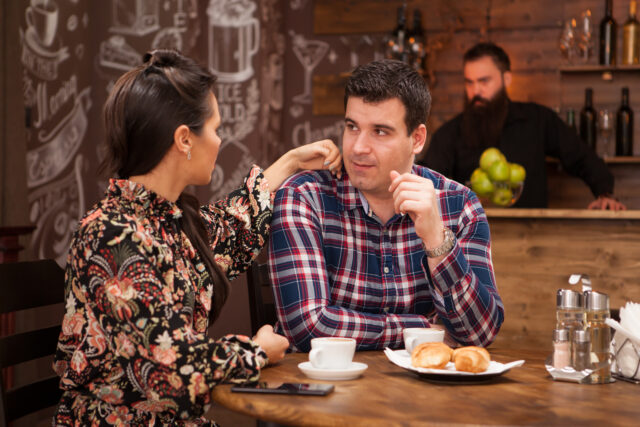Reading people doesn’t require playing mind games or turning into a human lie detector.

It’s about tuning into subtle cues, emotional patterns, and body language so you can understand what someone’s really feeling, even when their words say otherwise. While some of this comes from experience and instinct, there’s a lot of psychology behind it too. Here are some tips that psychologists consistently use to read people more clearly—without overthinking it or making it weird.
1. Watch how someone treats service workers.

If you want to understand someone’s real character, observe how they treat people who aren’t in a position to offer them anything. Rudeness, impatience, or acting superior tells you way more than their charm with you ever could. Kindness towards people they don’t “need” shows emotional maturity and respect. It’s a small but powerful window into their values.
2. Look for mismatched words and tone.

When someone says, “I’m fine” but their voice is tight or their smile doesn’t quite reach their eyes, that mismatch is a clue. The brain and body don’t always lie in sync. Emotional honesty often shows up more in how something is said than what’s actually said. Pay attention to tone—it’s often more truthful than the sentence.
3. Notice how they make space, or don’t, for other people.

Do they dominate conversations or create room for other people to share? People who interrupt constantly or steer things back to themselves often crave control or validation. True confidence makes space. Someone comfortable in their own skin doesn’t need to hijack every chat and steal the spotlight.
4. Pay attention to how they listen.

There’s listening to reply, and then there’s listening to understand. People who truly hear you won’t just nod along—they’ll ask thoughtful follow-ups or remember little things you said weeks ago. It’s a subtle sign of emotional depth, and it’s a skill that can’t really be faked for long.
5. Watch for mirroring.

People often mimic the body language of those they’re comfortable with—leaning in, matching posture, or echoing gestures. It’s an unconscious way of building trust. If someone’s mirroring you, they’re likely engaged and feel safe around you. If they stiffen or pull back, something might be off.
6. See how they act when no one’s watching.

People reveal a lot when they’re not “on.” The way someone behaves when they think it doesn’t count says more than what they do for show. Do they litter? Cut corners? Act dismissively to people? You’ll learn a lot by simply observing quietly in everyday settings.
7. Look at how they handle being wrong.

Do they get defensive, lash out, or shut down? Or can they pause, reflect, and own up to mistakes? That response reveals emotional intelligence fast. Being able to say “I got that wrong” without ego is a rare trait, and one that tells you that you’re dealing with someone who’s growing, not just performing.
8. Gauge their comfort with silence.

Some people fill every gap in conversation because silence feels awkward, while others are totally okay with a bit of stillness. That difference speaks to how at ease they are with themselves. If someone can sit with a quiet moment without rushing to fix it, they probably don’t need constant validation to feel secure.
9. Notice how they respond to boundaries.

Setting a boundary is a great test. People who respect your “no” without pushing back or guilt-tripping you are emotionally safe to be around. If they react with anger, sulking, or passive-aggressiveness, you’ve learned something important: they’re more invested in access than respect.
10. See how they deal with other people’s success.

When someone you know succeeds, do they get supportive, or suddenly distant or competitive? Envy can be quiet but noticeable. If they cheer you on without backhanded comments or making it about themselves, that’s someone with secure self-worth.
11. Watch their eyes when emotions run high.

The eyes often reveal what the mouth doesn’t. People will glance down when feeling guilty, away when uncomfortable, or lock eyes when trying to prove something. You don’t need to overanalyse every blink, but changes in eye contact during emotional moments say a lot.
12. Track consistency over time.

Anyone can be nice on a good day. The real test is whether their values, behaviour, and moods hold steady, or swing unpredictably based on what they want. Psychologists look at patterns, not one-off moments. If you spot consistent contradictions, it’s worth asking what’s behind them.
13. See what makes them uncomfortable.

People often reveal their insecurities through what they mock or avoid. If they roll their eyes at vulnerability or deflect with jokes, they might be guarding something deeper. Comfort zones tell stories. Discomfort isn’t bad—it just helps you understand someone’s emotional range and what they might be protecting.
14. Pay attention to physical pacing and fidgeting.

Rapid speech, pacing, or constant fidgeting can indicate anxiety, overstimulation, or even deception. Stillness doesn’t always equal calm, either—it might mean shutdown. What you’re looking for isn’t perfection, but whether the person seems regulated in their own skin, or stuck in fight-or-flight mode more often than not.
15. Notice how they treat your vulnerability.

If you share something raw, and they lean in, get soft, or respond with care, you’re in safe territory. If they joke, change the subject, or go cold, it’s worth clocking that too. How someone handles your vulnerable moments tells you if they’re capable of emotional intimacy or just here for the surface-level stuff.
16. Observe how they behave under stress.

Stress squeezes out a person’s real tendencies. Do they lash out, retreat, blame other people, or get short-tempered? Or do they stay grounded and communicative? Their reaction in tough times is more revealing than how they act when everything’s easy. Emotional regulation shows up in the messy bits.
17. Listen for emotional vocabulary.

People who can name their emotions—“I’m overwhelmed,” “I’m sad,” “I feel uneasy”—are generally more self-aware and emotionally attuned than those who just say “I’m fine.” It’s not about using fancy language. It’s about being emotionally literate enough to know what’s happening inside and share it honestly.
18. Look at how often they blame other people.

People who constantly blame other people for their problems usually aren’t doing much inner work. If they’re always the victim in every story, you’re probably not getting the full truth. Accountability is a huge green flag. The more someone owns their stuff, the easier it is to trust them emotionally.
19. See how they treat your “no” the second time.

The first time you set a boundary, some people back off—momentarily. However, if they come around again, trying a different angle? That’s someone testing your limits. Reading people isn’t just about the big moves. It’s watching for patterns of pushback and how much they really honour what you ask for.
20. Notice how you feel in their presence.

Sometimes your nervous system figures things out before your brain does. If you consistently feel anxious, drained, or on edge around someone, trust that feeling. It means something’s off. Being with someone who’s emotionally safe will make you feel relaxed, not tight. Don’t ignore your body’s cues—they’re one of your best tools for reading people.




